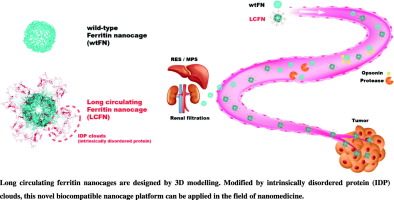Journal of Controlled Release ( IF 10.5 ) Pub Date : 2017-08-15 , DOI: 10.1016/j.jconrel.2017.08.014 Na Kyeong Lee , Eun Jung Lee , Soyoun Kim , Gi-hoon Nam , Minwoo Kih , Yeonsun Hong , Cherlhyun Jeong , Yoosoo Yang , Youngro Byun , In-San Kim

|
Ferritin nanocages are of particular interest as a novel platform for drug and vaccine delivery, diagnosis, biomineralization scaffold and more, due to their perfect and complex symmetry, ideal physical properties, high biocompatibility, low toxicity profiles as well as easy manipulation by genetic or chemical strategies. However, a short half-life is still a hurdle for the translation of ferritin-based nanomedicines into the clinic. Here, we developed a series of rationally designed long circulating ferritin nanocages (LCFNs) with ‘Intrinsically Disordered Proteins (IDP)’ as a stealth layer for extending the half-life of ferritin nanocages. Through predictions with 3D modelling, the LCFNs were designed, generated and their pharmacokinetic parameters including half-life, clearance rate, mean residence time, and more, were evaluated by qualitative and quantitative analysis. LCFNs have a tenfold increased half-life and overall improved pharmacokinetic parameters compared to wild-type ferritin nanocages (wtFN), corresponding to the low binding against bone marrow-derived macrophages (BMDMs) and endothelial cells. Subsequently, a tumor targeting moiety, epidermal growth factor receptor (EGFR)-targeting affibody peptide, was fused to LCFNs for evaluating their potential as a theragnostic platform. The tumor targeting-LCFNs successfully accumulated to the tumor tissue, by efficient targeting via active and passive properties, and also the shielding effect of IDP in vivo. This strategy can be applied to other protein-based nanocages for further progressing their use in the field of nanomedicine.
中文翻译:

具有固有紊乱的蛋白质和亲和体的铁蛋白纳米笼:具有扩展药代动力学的靶向肿瘤的平台
铁蛋白纳米笼由于其完美而复杂的对称性,理想的物理特性,高生物相容性,低毒性以及易于通过基因或化学方法进行操作而作为药物和疫苗输送,诊断,生物矿化支架等的新型平台特别受到关注策略。然而,半衰期短仍然是将基于铁蛋白的纳米药物翻译到临床的障碍。在这里,我们开发了一系列合理设计的长循环铁蛋白纳米笼(LCFN),并以“固有紊乱蛋白(IDP)”作为隐身层,以延长铁蛋白纳米笼的半衰期。通过3D建模的预测,设计,生成了LCFN,其药代动力学参数包括半衰期,清除率,平均停留时间等,通过定性和定量分析进行评估。与野生型铁蛋白纳米笼(wtFN)相比,LCFN的半衰期延长了十倍,整体药代动力学参数得到了改善,这对应于对骨髓衍生的巨噬细胞(BMDM)和内皮细胞的低结合。随后,将靶向肿瘤的部分,即靶向表皮生长因子受体(EGFR)的亲和体肽与LCFN融合,以评估其作为吻合平台的潜力。通过有效靶向,肿瘤靶向LCFN成功地积累到肿瘤组织中 随后,将靶向肿瘤的部分,即靶向表皮生长因子受体(EGFR)的亲和体肽与LCFN融合,以评估其作为Therasnostic平台的潜力。通过有效靶向,肿瘤靶向LCFN成功地积累到肿瘤组织中 随后,将靶向肿瘤的部分,即靶向表皮生长因子受体(EGFR)的亲和体肽与LCFN融合,以评估其作为吻合平台的潜力。通过有效靶向,肿瘤靶向LCFN成功地积累到肿瘤组织中通过主动和被动特性,以及IDP在体内的屏蔽作用。该策略可以应用于其他基于蛋白质的纳米笼,以进一步发展它们在纳米医学领域的应用。











































 京公网安备 11010802027423号
京公网安备 11010802027423号